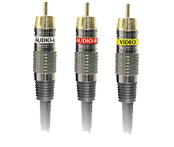 |


TechnoFILE is copyright and a registered trademark © ® of
Pandemonium Productions.
All rights reserved.
E-mail us Here!

Tuning Your Home Theater AffordablyBy Jim Bray Part Two: The Components We Used Part Four: Buying a Projection TV Part Five: Accessorizing Part Eight: More on Buying Speakers Did you know that you can make your home theater perform better by making a few modest upgrades that don’t even come close to breaking the bank? A little tweak here and there can be an excellent way to augment today’s affordable Dolby Digital-equipped audio/video receivers (which have become so cheap they’re almost giving them away in Wheaties boxes), and the mainstream speakers most of us have on hand. I’m speaking about things like patch cords and speaker wire, stuff that’ll give you more bang for your buck without causing you to take out a second mortgage on your house. You don’t even need to look farther than the big “mainstream” companies for such equipment, either. Though snobs may want to look down their noses at the RCAs and Panasonics of the world, in my experience these companies have traditionally offered good value and equipment that’s, for the most part, easy to use and easy to live with. RCA sent me a couple of examples from its line of accessory gadgets and doodads and, while they obviously aren’t in the same league as the really high end stuff I’d buy if I won the lottery, they’re workable solutions for people who can’t or won’t justify paying hundreds of dollars for a lousy cable, wire, or cord. Take patch cords, for example. Quite simply, the connecting cables that come with most audio and/or video components (if they even bother to include any) are generally as cheap as the manufacturers can get away with, so upgrading them can be an excellent investment. RCA’s HP (“High Performance”) series of cords will only set you back twenty bucks or so (depending on which cables you buy and how long they are) and they’re a good place to start. The cables feature 24K gold plated connectors and oxygen-free copper wire, as well as an “aluminized” mylar shield to cut down on signal interference. Did they make an audible difference? Yes - not as much as the $100 Monster cables I also have, but what do you expect? Surge protectors are really glorified power bars, except they can also help protect your toys from power spikes that could potentially fry them - and the best of them are supposed to scrub the electronic crud out of your power line. They don’t work miracles, but they help. RCA's $40 SCTV160 is a surge protector that has room for eight power plugs, a phone/modem line, and your coaxial cable or satellite TV feed. It even comes with a phone cord, a length of coax, an audible alarm (which, fortunately, I never had to experience!) and indicator lights that tell you it’s working as it’s supposed to. A master power button turns on and off the components hooked into it. The CVH920 “Video Source Selector” ($80) is a nice tool for people who’ve collected more toys than they have places to connect them. Its rear panel has inputs for six components, and one more on the front (which is great for hooking in a camcorder). A single output goes to your TV. All the connectors include RCA-type (which means "garden variety") audio and video jacks as well as the higher end video “S-Connectors.” The little box doesn’t come with its own remote control, but it has a “learn” feature that lets you teach it to work with your other equipment’s remotes. This is excellent news for couch potatoes, because it means they won’t have to get up and walk over to the source selector, thereby expending unnecessary energy. One of the most important upgrades you can make is to your speaker wire. There are a zillion types of wire, costing from pennies to “manybucks” per foot. I recommend you spend as much as you can afford, and I speak from experience. I’d been using “dollar a foot” wire before springing for some “middle high end” Monster cables, and the difference was immediately audible. It was almost like getting new speakers. Almost... These are only a few examples of easy home theater tweaks, and the difference they can make in your room will depend a lot on how much you spend and where you spend it. Even if you only make a few key enhancement, however, you can receive a noticeable improvement that’ll boost your home theater enjoyment for years. Next we'll start looking at the audio side of things. Jim Bray's technology columns are distributed by the TechnoFILE and Mochila Syndicates. Copyright Jim Bray.
|
|
|
| Support TechnoFile via Paypal |
| TechnoFILE's
E-letter We're pleased to offer our FREE private, subscription-based private E-mail service. It's the "no brainer" way to keep informed. Our Privacy Policy |